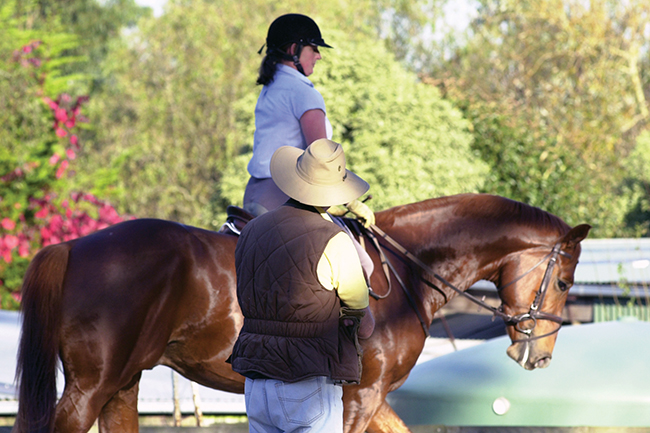 Over the years we have been making The Horse Magazine we have tried very hard to keep the fakes and phonies out of our pages. Sure, there have been one or two who have slipped past our guard, but on the whole, we have succeeded. And I promise you that over those years, we have seen many many fakes who have flourished in Australia, and sadly there are quite a few of them still on the scene, often with a loyal band of followers.
Over the years we have been making The Horse Magazine we have tried very hard to keep the fakes and phonies out of our pages. Sure, there have been one or two who have slipped past our guard, but on the whole, we have succeeded. And I promise you that over those years, we have seen many many fakes who have flourished in Australia, and sadly there are quite a few of them still on the scene, often with a loyal band of followers.
What was our method? Simple, as I pointed out to one well-known (level 3) instructor, who kept pestering us for an article on him, there are two tests, either show me a horse you have produced, or a rider you have produced, and then we’ll let you feature on our pages. The instructor recently retired without ever doing either.
Yet, I am constantly amazed that riders don’t apply this simple evaluation to the people they choose to spend their valuable time with, or entrust their much loved equine, not to mention, handing over large sums of money. It is even sadder when the rider saves heaps of money to go to Europe for training, and goes straight to some phony, who has never produced a successful horse, or a rider.
It isn’t that hard. If someone claims to have produced a string of Grand Prix horses, and they really exist, then you will find them on the FEI database. It’s free, and it’s easy to use. Google FEI, look at the top left hand side of the page for DATABASE and follow the prompts.
One of, if not the first, of the great showjumping trainers in the United States, where there are many very good trainers (and just as many fakes) was Gordon Wright. Here are his ‘commandments’ for a good teacher:
A Good Teacher
1. Is sure of his subject
2. Seeks to create development in each student
3. Looks for new experiences and problems
4. Avoids sarcasm and never ridicules a pupil
5. Should be enthusiastic about learning
6. Inspires confidence
7. Should prevent physical fear, since it is impossible to learn with it
8. Should simplify words and actions
9. Should not be a perfectionist, because this is difficult for most students to live with
10. Should be a demonstrator and a trainer, thus inspiring the pupil to make continual progress
11.Should be especially aware of appearance while riding
12. Should have a specific daily lesson plan.
Oh yes, in an era before the mobile phone, Gordon warned against the landline:
“The demon of the professional instructor’s life is definitely the telephone. Make it clear that lessons will not be interrupted by a telephone call. Keep specific times during which appointments and cancellations will be made, and then hold it at that. During the working day, it is far better to ignore the ringing telephone than to mess up the schedule with frequent interruptions.”
One of the problems is that everyone has learned to talk the talk. I remember watching one of the more prominent showjumping trainers give a lesson: “Get the horses round, get them loose through the back, giving to the rein, before we jump…” And then, as the three in the lesson continued to career around the circle, horses’ noses in the air, jaws locked again the riders’ ugly hands, backs hollowed and upside down, with canters like a startled chook, “very good, now let’s jump.”
Sometimes it is not clear whether the trainer is ignoring how badly the horse is going because he or she doesn’t know better, or because they are not prepared to lose a client. It has been interesting to watch how quickly some of the imported trainers have fallen into line.
Imported trainers present another concern. Given how much larger and more prosperous the equestrian industry is in Europe, you have to worry about why this latest maestro has decided to settle in Australia? Once again, a little background fact checking is probably advisable…
There is one rule that should never ever be ignored. If the instructor claims to have new techniques of his own, that are different from the traditional methods, quickly load your horse on the float and drive away.
It is a good idea to analyse what you want from your instructor. If you are planning on an Olympic gold medal, then obviously your choice of trainers is going to be extremely limited – but don’t forget some very basic techniques can help even the elite.
I can remember the first time I visited Carl Hester’s stables, many years ago, and he told me about a young woman, whose name no one would recognize, with perfectly respectable BHS qualifications, who sat in the corner once a week and said, heels down, your hands are too high, you have hollowed your back, your knee has come in front of your hip, none of it rocket science, but hey, look at the result.
Another example was one of our young eventers, who was suddenly getting much better dressage scores. The answer was simple, his German trained girlfriend was putting him on the lunge, stirrups crossed, no reins, a couple of times a week. I am prepared to bet that 75% of the riders on our elite squads would sit way better if they would suffer the indignity regular lunge lessons.
The other thing to remember is that different riders respond differently to different trainers. If our riders all came through something like the German system, where they all master the same set of basics, and develop the same ability to sit and give the aids, then one coach can work with all the elite riders (although they all have different coaches back home). Our dressage riders are much more difficult to teach because they are not grounded, and bring even to the top level, degrees of eccentricity in their riding. This means that it is far smarter to go with the present system of each rider working with the coach of their choice, with the team advisor in a managerial rôle, but ready to help if the rider’s own coach is not available.
But there are plenty of riders, indeed the overwhelming majority, who don’t even dream of international success, who just want to be happy and confident riding their own horse – and there are plenty of good teachers at this level. Once again, check things out, talk to riders who train with that coach and check if what they are doing, is what you want to do.
Watch the coach teach, is that the sort of instruction you respond positively to? If the coach gets on and rides, do you like the riding style – more importantly, does your horse respond positively. But please, when you do select a coach, and you go to a lesson, unless the instructor suggests something that is impossible or outright dangerous, don’t answer back, do it.
I’ll never forget seeing visiting Danish Olympian, Princess Nathalie, giving a lesson, and the rider was arguing back. How long do you think you would have lasted with Klaus Balkenhol, if you argued back? “You wouldn’t,” was Nathalie’s reply. Sometimes I think Australian riders go to clinics with visiting instructors not to learn from the visitor, but so that the visitor can learn how brilliant the rider’s horse is, and how wonderfully they ride…
At the end of the day, it is also worthwhile remembering Alois Podhajsky’s wonderful insight, My Horses, My Teachers:
“When riding and training my horses I was forever trying to put myself in the place of the animal and to think from his point of view, especially in order not to demand more than he could perform. Retrospectively I realize that the constant effort to understand the creature entrusted to my care became the reason why, though I was their trainer, I feel as their pupil today. Although they had no faculty of speech, they taught me more than many humans did.”
“I have often met two-legged instructors who did not rank among the good ones, because they asked their pupils more than they were able to perform themselves. A good instructor should first of all set an example through his own knowledge and ability; then the pupil will follow his orders willingly. Only the teacher who has himself mastered what he is teaching will know better and never ask more of his pupil than he is able to do. It is human nature for the student to try to seek an excuse or an explanation for his lack of knowledge. If, on the other hand, the teacher is not able to demonstrate what he demands, all his corrections and reprimands, will not impress the pupil, who will only think: ‘You cannot do it yourself!’ One of the worst is the teacher who is himself inclined to treat his horse roughly but who rebukes or worse, shouts at his pupil for the same offence. Would the latter not think of the proverb about preaching water and drinking wine and have no respect for his teacher?”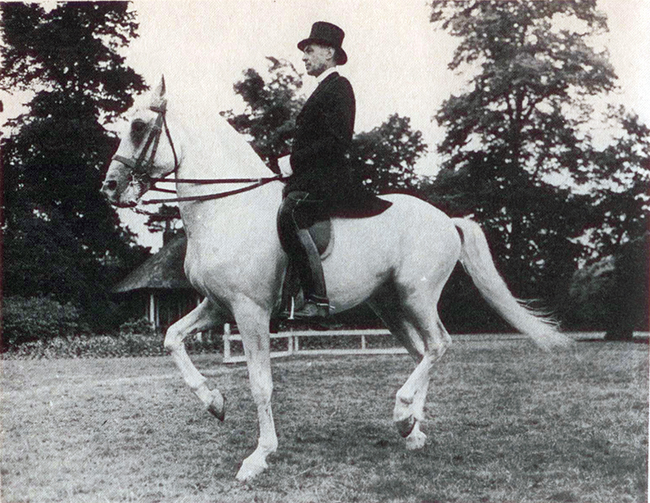
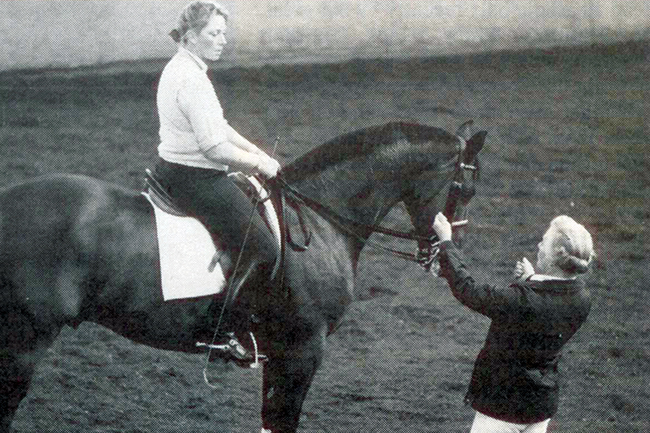 Rosemarie Springer, Olympic medallist for Germany and highly respected trainer worldwide.
Rosemarie Springer, Olympic medallist for Germany and highly respected trainer worldwide.
Frau Springer visited Australia in the 80’s and 90’s and THM was fortunate enough to share one of her clinics
What are the basic elements of the dressage philosophy?
“That you get the horse under your command. That the horse is willing – Losgelassenheit – the word does not exist in English. That the horse should give, and listen to your aids and respond. This is the main thing in dressage, in the whole of riding.”
“Not all horses can do this. You cannot take a horrible, badly conformed horse out of a cart and expect him to do this. You have to find a horse that has the ability to listen to your aids. A horse with the ability to respond.”
“I have had long experience of Grand Prix riding, how to get from one movement to another. That is very difficult. You have to produce a very difficult movement, and then re-gain the horse to respond to the new aids. It is difficult because at the same time you have to keep the horse calm and quiet.”
“We have seen that problem in our school here, where the horse gets nervous, then the rider gets nervous too. Then it is upon me to calm them both.”
How did you develop that skill to assess the rider so quickly? “Maybe it is a gift. I see it immediately. I see the need of a horse, or the need of a rider, or the need of them both – what you should tell the rider to do, and what you should bring into the horse at that very moment. This is the most important thing.”
“Perhaps I was born with it, but then it was all formed in me by Schultheis. He was a terribly strict teacher. I was not even allowed to talk in the six hours riding in the morning – not even allowed to talk to him! Not even allowed to ask a question. I just had to do what he said… twenty years long. Therefore I think it is upon me to give that knowledge to other people. If I would sit down at home and do nothing, I could not be happy – I must give that knowledge to other people.”
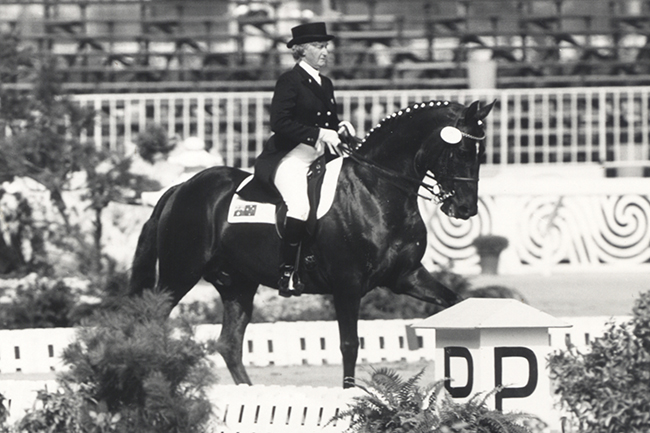
Erica Taylor Australian Olympic Dressage representative
What do you think of the direction that modern-day dressage is going?
“I think it is good that dressage is moving away from allowing the horse with a short, tight neck to be acceptable. There is a greater appreciation of the need for the back to swing and for the horse to be loose and supple. Also, there is more knowledge and better training available, especially for young riders. To be successful it is necessary for riders to have good material, but also the right training.”
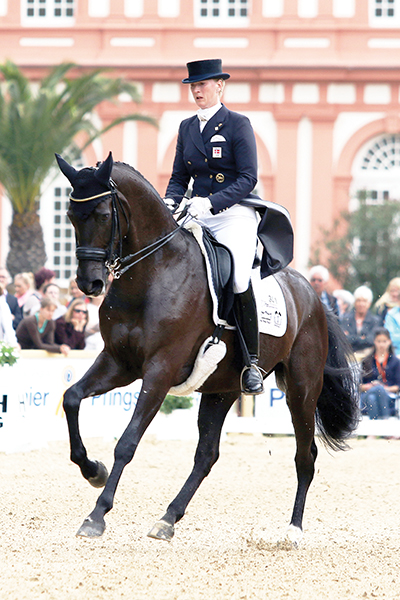 Princess Nathalie, Olympic medal winner for Denmark
Princess Nathalie, Olympic medal winner for Denmark
Do you think it is hard for riders in Australia. When you grew up, you were taught first by Kyra (Kyrklund), then by Klaus (Balkenhol), then Richard and Kyra again, there was never a time when you weren’t being looked at hard, and critically…
“That’s the whole point. You don’t have to always have those fantastic trainers, but you just have to have eyes on the ground, knowing in which direction you have to head. There are a lot of ways to Rome, and you can try different ways, but if you don’t know if you are really heading to Siberia, then it is difficult, that’s where you need the eyes on the ground.”
You say there are many ways to Rome, but really when we look at all the very good trainers of our time, they all have the same road map… “It is the same road map definitely, but you do need the right person on the ground, it doesn’t necessarily have to be Kyra or Klaus, but just somebody who knows the correct direction to Rome, then it can be a little bit via Munich or via Berlin, but it is important to have that person to tell you when it is right or when it is wrong.”
 Tad Coffin, Gold Medal eventer for the USA
Tad Coffin, Gold Medal eventer for the USA
Tad was perhaps the first eventing coach to show how professional and essential a coach can be, and how demanding – in a good way – the instruction can be…
It is Tad who farewells you with a phrase that deserves inscribing in the brain of every rider –
“The goal of any rider is to have the horse fall in love with your hands.”
It came as a surprise, especially in the mid-80’s that Tad, instead of pointing horse and rider at the biggest, scariest fences he could find, kept his students in the arena, concentrating on the work was simple, deceptively simple … There was an arena full of eventers, some of them moderately famous eventers, riding well performed horses and they are going over little Pony Club lines of cavalletti. Surely this was kids stuff – where are all those cross country fences?
Tad had a lucid and elegant explanation.
“One of the things that all good trainers have come to realise is that if you need to jump a course of five foot fences, you don’t need to jump five foot fences every day, or four times a week, or even three times a week, in order to prepare for that. You can break down the elements that are required, and work on them piece-meal and in a smaller version. I think that the Americans have honed this kind of idea, with the help of Bert de Nementhy, better than anybody else.”
“The idea is that there are four basic components to jumping. One is the rhythm that the horse is going in. The rhythm is in turn a compilation of his frame, his balance, his engagement, his impulsion and his speed.”
“The next element is balance – this is the balance that a rider has, not only in the approach but also in the air over the fence.”
“Then we have the track or the geometry of the course, and the final element in jumping is timing.”
“We must get into the spirit of the cavalletti, we must relentlessly attack any weakness.”
The pupils will find themselves relentlessly pursuing all manner of gymnastic exercises over the next few days.
“The idea behind gymnastics is that you can work on all of those elements of good jumping on a very low level. In regards to rhythm, the cavallettis require a very even pace. I can manipulate the horse’s rhythm at the last minute, so that he’ll be right through the cavallettis, and then not worry about rhythm all the rest of the way around the ring, until we are back at the cavallettis. Or I can say – ‘I want to establish a rhythm that at any moment I could go through the cavalletti and the horse would go trot, trot, trot, trot – very even’. That is the strategy we adopt so that the cavallettis are useful.”
“You must get away from belligerence with young horses, you must get the horse to the point where it loves your attitude. Try to make your aids invisible, try to make them inviting.”
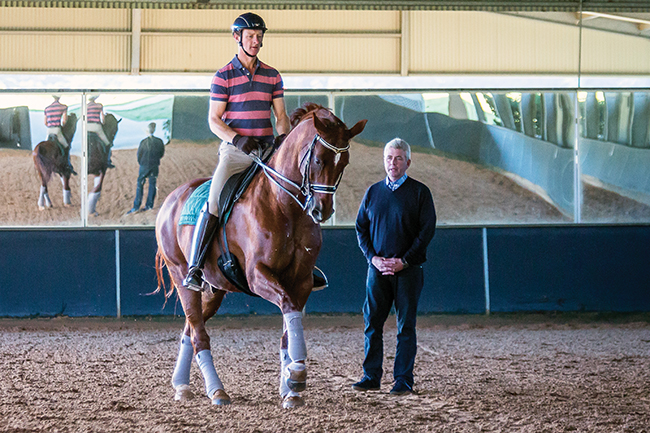 Hans Heinrich Meyer zu Strohen
Hans Heinrich Meyer zu Strohen
“Every rider has his own future, own dream for a horse or special riding or training. He must think more and look more to these things, and then he will with this person or work with that particular trainer. As they progress, sometimes it changes as well. A young rider will have a dream and see it on the video or see it at a show and they will think, “That is my dream, that is my riding.” When we don’t have a dream or see something we like, we don’t have a way, so we must always be looking.”
“You must have everything! Special for the rider all the time, is strong concentration. Concentration in myself and of my body. Out of this feeling I get the feeling and the information from the horse. The flow from my body to and from the horse, and also to the teacher over there. Teacher, rider, horse must go like this, forward, backward, forward, backward with the flow of information. When I sit alone on the horse without a teacher, I must get that feeling back and try it and feel it again.”
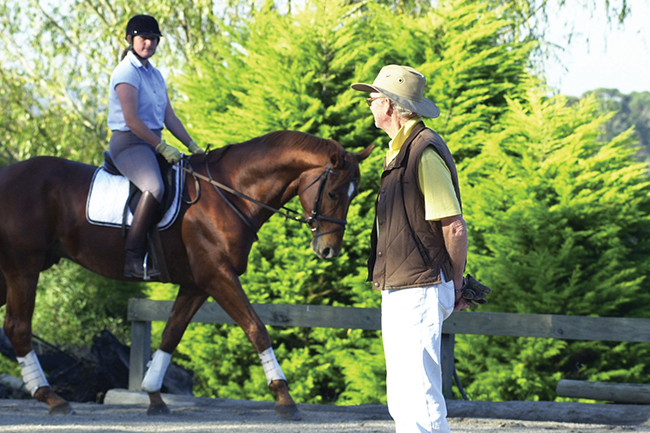 Back to the trainer who featured in the opening photo, Malcolm Barns, one of the very first Australians to learn his craft in Europe and bring it back to Australia:
Back to the trainer who featured in the opening photo, Malcolm Barns, one of the very first Australians to learn his craft in Europe and bring it back to Australia:
“In Europe, if they are tall, short, thick, thin, chubby, it doesn’t matter – because of their early exercises, and watching role model competition riders, then most of them can sit in, and sit deep. By contrast, most of our riders are ‘perching’, trying as they have been taught to ‘sit up’, shoulders back, heels down, etc., they are stiff as boards. They are unable to absorb their horse’s movement, let alone influence it with the balance and movement of their own bodies – they would fall off if they let the reins go.
The horses defend themselves successfully, becoming insensitive to the bit and the legs, becoming behind the vertical and short in the neck, losing movement as a result.
But, sitting correctly is not just a talent in the realm of lucky naturally gifted riders, understanding the mechanics of our bodies can be learnt. Once the rider learns to do this, the horse becomes more relaxed and comfortable because of the rider’s suppleness and balance. Riders must learn to sit, not just with a rounded base of the spine, but by tilting the pelvis forward and up, sitting on the back of the seat bones.
Seat bones are not like knobs, but like skis or skateboards. And then, as the pelvis is of course attached to the spine, the LORDOSIS (the forward facing spinal curvature in the lower back) is able to oscillate as a result of the rocking movement of the pelvis…
So, now that you can sit we have to learn how to use it.”
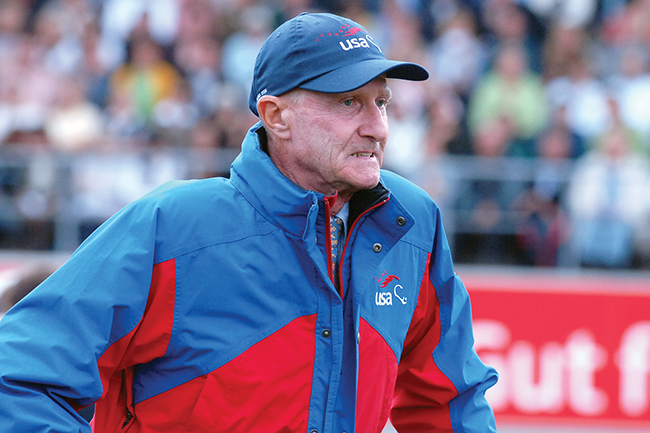 And no piece on good trainers would be complete without George Morris. Here’s some quotes from him to finish.
And no piece on good trainers would be complete without George Morris. Here’s some quotes from him to finish.
“You have to ask the horse to get clever with the construction of the fences, that’s why there is a false ground line on the final vertical with the rail on the far side. Horses don’t like false ground lines, but they have to work for a living. They have to become agile and intelligent.”
“That’s perfect, now he starts working for a living. No one arrives at every fence perfect WORK IT OUT. The fence has to hold the horse, the fence has to round the horse, not you. Let the fence help you do the work. With any habit, first it is difficult, then it is easy, finally, it is beautiful.”
“Legs are so important because of impulsion, which to me is the first lesson you give the horse, not rhythm. You lead a colt, you back a colt, will it go forward? My definition of impulsion is does the horse think forward? The second duty of the inside leg is the basis of collection. People think about the top of the horse when they think collection, but it is the inside hind leg that comes under the body shadow of the horse, that starts the back to front collecting of the horse. Nothing, nothing that I teach did I invent. I put things together maybe in an interesting package, but I didn’t invent any of this.”


Fabulous to read those wonderful words of wisdom again,especially from Malcome Barns, as he gave me my very first lessons at Oakwood.And yes ,some were on the lunge. Still competing 46 years later….never at GP, but at levels my horses and I can achieve.
Some of todays instructors should heed the comment about ignoring the phone ,while they are being paid to teach !